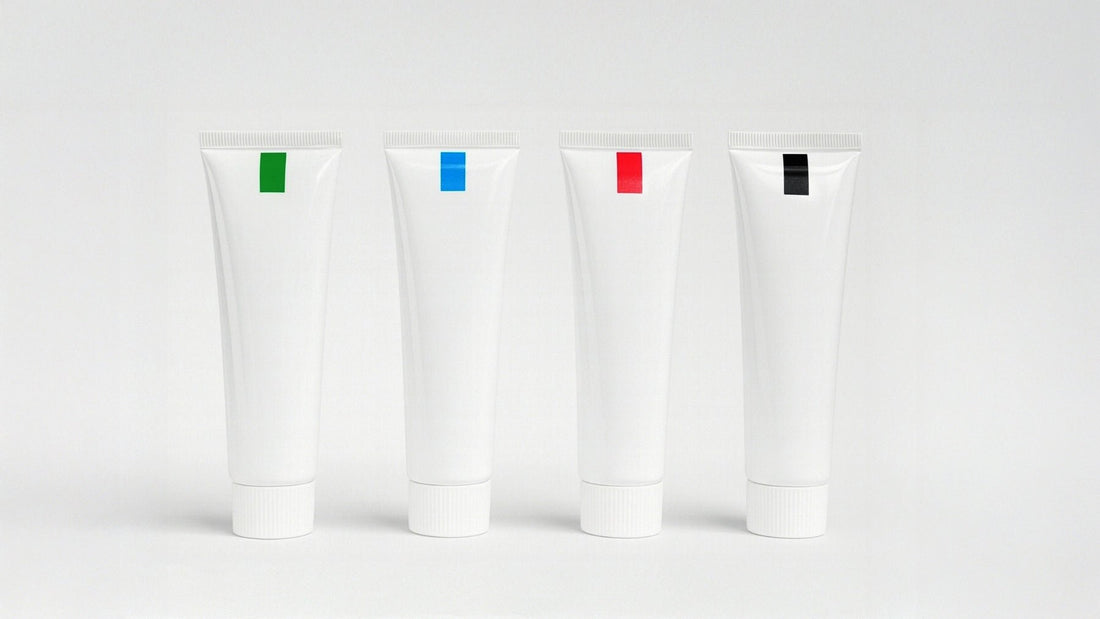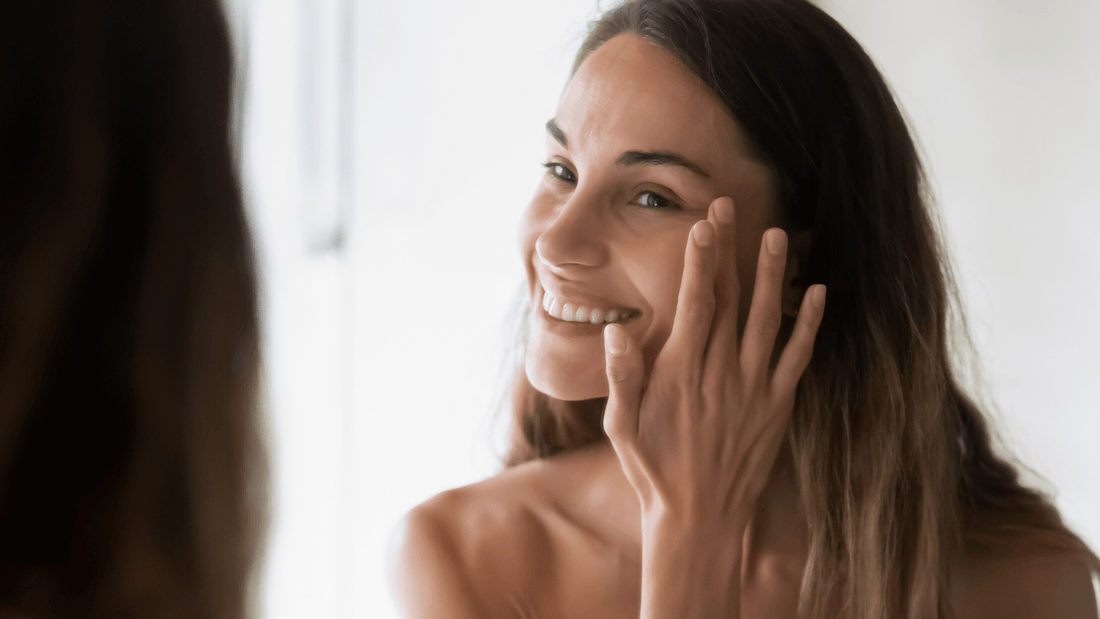The answer to the question of what hormonal acne is is that it's a type of acne that develops due to fluctuations in hormone levels and is generally inflammatory. It's particularly common in women due to changes in the estrogen-androgen balance [1,2]. Factors such as the menstrual cycle, pregnancy, PCOS, stress, and androgen receptor sensitivity can trigger this condition. In men, this type of acne is less common because androgen levels are more stable [2].
What are the symptoms of hormonal acne?
Hormonal acne (pimples) is a skin condition characterized by recurring, deep lesions, usually concentrated on the lower face. It's not limited to adolescence but is also common in women aged 20 and older. So, how can hormonal acne be diagnosed?
Acne Around the Jawline and Neck
Hormonal acne most commonly occurs around the jawline, around the mouth, lower cheeks, and neck. The sebaceous glands in these areas are more sensitive to androgen hormones. Due to fluctuations in hormone levels, various types of lesions, such as papules, pustules, nodules, and cysts, can occur in these areas. This distribution pattern is considered characteristic of hormonal acne, especially in women aged 20 and older [3].
 Cystic Structures That Thicken Before Menstruation
Cystic Structures That Thicken Before Menstruation
The menstrual cycle is a period of natural fluctuation in women's hormone levels. Especially during the luteal phase (the period following ovulation), the relative increase in androgen hormones leads to increased seborrhea (oil production) in the skin. This can lead to clogged pores and the development of inflamed, deep-seated, cystic lesions.
Research shows that acne lesions that occur during this period are more often nodules and cysts, accompanied by comedones, rather than superficial lesions. They are generally painful, slow to heal, and recurrent. Therefore, deep pimples that appear in similar areas before each menstrual period should be considered a significant indicator of hormonal acne [4].
Persistent, Recurring Acne
It's one of the most distinctive features of hormonal acne. Recurring comedonal or cystic lesions, particularly in the same area, offer limited response to conventional acne treatments. Studies have highlighted that this form of acne is more common in women who smoke and are older, and that the comedonal component can often be overlooked [5].
 What Causes Hormonal Acne?
What Causes Hormonal Acne?
Hormonal acne occurs when androgen hormones (testosterone and DHEA-S) specifically stimulate the sebaceous glands, increasing sebum production. This leads to pore blockage and inflammation. Hormonal changes such as menstrual cycle, PCOS, birth control pills, pregnancy, and menopause, as well as environmental factors such as stress, lack of sleep, and a high-glycemic diet, can exacerbate acne. Additionally, the skin's hypersensitivity to androgen hormones can also cause hormonal acne [1,6,7].
Hormonal imbalances (especially increased androgens)
Hormonal imbalances, particularly increased androgen (testosterone, dihydrotestosterone (DHT)) and decreased estradiol levels, are among the primary causes of hormonal acne in adult women. The significant reduction in acne severity observed with the correction of these imbalances highlights the importance of hormonal regulation in treatment [1].
The effect of stress and cortisol
Chronic stress raises the hormone cortisol in the body, which can trigger sebum production and increase hormonal acne [7].
The effect of eating habits on hormones
High-glycemic index diets may increase acne severity. Those on a low-glycemic load diet experienced decreased acne, weight, body mass index (BMI), and androgen levels, while insulin sensitivity increased.
Studies linking dairy consumption to acne are limited, but consuming skim milk, in particular, may increase acne risk. No such association has been found with cheese and yogurt. Ice cream is also among the dairy products that increase acne risk [5].
 Natural Solutions for Hormonal Acne Instead of Hormone Medications
Natural Solutions for Hormonal Acne Instead of Hormone Medications
While the answer to the question "How do I get rid of hormonal acne?" is often associated with hormone medications, the unwanted side effects of these treatments can be a concern for many. For those with OR who are seeking more natural, low-side-effect, and long-term sustainable solutions and are making informed choices, herbal ingredients and scientifically based supplements can offer powerful alternatives. These natural treatments affect sebum production, bacterial growth, inflammation, and keratinization. They also contribute to hormonal acne treatment by providing moisturizing and soothing effects when applied topically (on the skin).
- Green Tea: Its antioxidant, anti-inflammatory and antibacterial properties provide benefits in cases of inflammatory acne.
- Resveratrol: Reduces inflammatory response and helps manage acne symptoms by inhibiting the growth of P. acnes bacteria.
- Rosa Damascena (Damascus Rose): It contributes to acne treatment with its antioxidant, anti-inflammatory, antimicrobial effects and lipid peroxidation inhibitor properties.
- Tea Tree Oil: When applied topically, it shows antimicrobial and anti-inflammatory effects, heals inflammatory acne lesions and supports acne treatment.
- Probiotics: The antimicrobial properties of probiotics may also help alleviate acne symptoms [6,7].
Creating a daily skin care routine
Gentle cleansers, non-comedogenic products, and regular exfoliation should help strengthen the skin barrier. To discover the importance of proper skincare in combating hormonal acne and learn which products are best for your skin type, be sure to read our article : Skin Care Tips by Skin Type .
Ingredients Like Niacinamide and Azelaic Acid
Niacinamide (B3) supports the skin barrier by replenishing moisture to skin irritated by the drying effects of acne treatments [8]. Azelaic acid, naturally found in wheat, barley, and rye, accelerates skin cell turnover and reduces inflammation, alleviating the appearance of blemishes and acne [9].
Supplements: Zinc, Omega-3, DIM
Zinc is effective against acne by balancing sebum production and reducing inflammation. While omega-3 fatty acids have anti-inflammatory properties, studies on their effects on acne are inconsistent, and more research is needed. Diindolmethan (DIM) is found in some vegetables, particularly cabbage, broccoli, and cauliflower. It has been shown to balance hormone levels, making DIM suitable for treating hormonal acne [10].
Daily Tips to Prevent Hormonal Acne
In treating hormonal acne, not only medication but also lifestyle changes are important; simple habits reduce the risk of acne by maintaining hormonal balance.
Reducing refined sugar and dairy
High glycemic index foods (foods containing refined sugar) raise insulin levels, leading to increased androgen hormones. This, in turn, increases sebum production, contributing to clogged pores and acne [11].
Dairy products, especially cow's milk, similarly stimulate the sebaceous glands through the IGF-1 and hormones it contains and can exacerbate hormonal acne by increasing inflammation [11].
Paying attention to your sleep patterns
Insufficient sleep disrupts hormonal balance by increasing cortisol levels and triggers sebum production, paving the way for acne; regular sleep of 7-9 hours a day prevents this process and supports skin regeneration [7].
Reducing daily stress levels
Chronic stress triggers hormonal acne by increasing cortisol and raising androgen levels; stress management techniques such as mindfulness, breathing exercises, exercise and meditation help control acne by reducing these hormonal imbalances [7].
Conclusion
Hormonal acne is not merely a superficial skin condition; it is the clinical manifestation of underlying hormonal and environmental factors on the skin. Effective management requires a holistic approach to addressing daily life factors such as sleep patterns, stress management, healthy eating, and skin care habits, in addition to medical treatments. This approach not only alleviates acne symptoms but also allows for sustainable skin health [1,2,4,6].
SOURCE:
1. Thomas, J., Parimalam, K., & Sindhu, R. B. (2013). Hormonal acne: leading to a paradigm shift in the management of acne. Expert Review of Dermatology, 8(3), 225-227.
2. Kamangar, F., & Shinkai, K. (2012). Acne in the adult female patient: a practical approach. International journal of dermatology, 51(10), 1162-1174
3. Thiboutot, D. (2001). Hormones and acne: Pathophysiology, clinical evaluation, and therapies. Seminars in Cutaneous Medicine and Surgery, 20(3), 144–153.
4. Zaenglein, AL, Pathy, AL, Schlosser, B.J., Alikhan, A., Baldwin, HE, Berson, DS, ... & Bhushan, R. (2016). Guidelines of care for the management of acne vulgaris. Journal of the American Academy of Dermatology, 74(5), 945–973.
5. Bhadra, P. (2020). A literature review on acne due to hormonal changes and lifestyle. Indian Journal of Natural Sciences, 10(59), 18507-18521.
6. Sundene, N., & Doctor, N. Hormonal Acne: “Hormones and Acne” Holistic Dermatology Meets Natural Endocrinology!.
7. Madan, P. A Study on the Impact of Hormonal Imbalances on Acne Severity in Adult Females.
8. Permatasari, NJ, & Tan, ST (2024). Efficacy of Topical Niacinamide on Skin Hydration of Adolescents with Acne Vulgaris: An Experimental Study on the Adolescent Community in Jakarta, Indonesia. Bioscientia Medicina: Journal of Biomedicine and Translational Research, 8(9), 4987-4995.
9. Vargas-Diez, E., Hofmann, M.A., Bravo, B., Malgazhdarova, G., Katkhanova, O.A., & Yutskovskaya, Y. (2013). Azelaic acid in the treatment of acne in adult females: Case reports. Skin Pharmacology and Physiology, 27(Suppl. 1), 18–25.
10. Rubin, M. G., Kim, K., & Logan, A. C. (2008). Acne vulgaris, mental health and omega-3 fatty acids: a report of cases. Lipids in health and disease, 7(1), 36.
11. Spencer, E.H., Ferdowsian, HR, & Barnard, N.D. (2009). Diet and acne: a review of the evidence. International journal of dermatology, 48(4).





